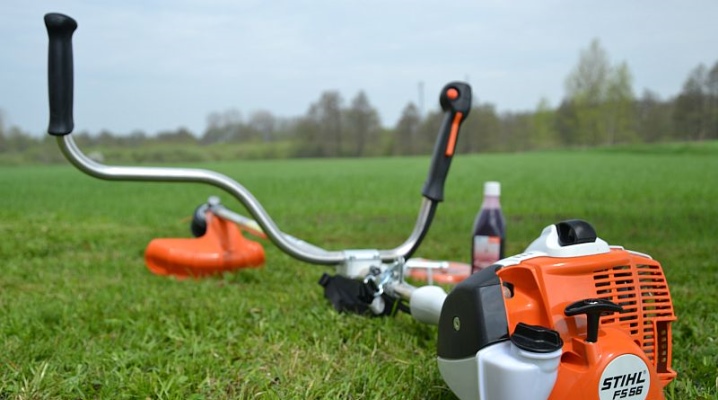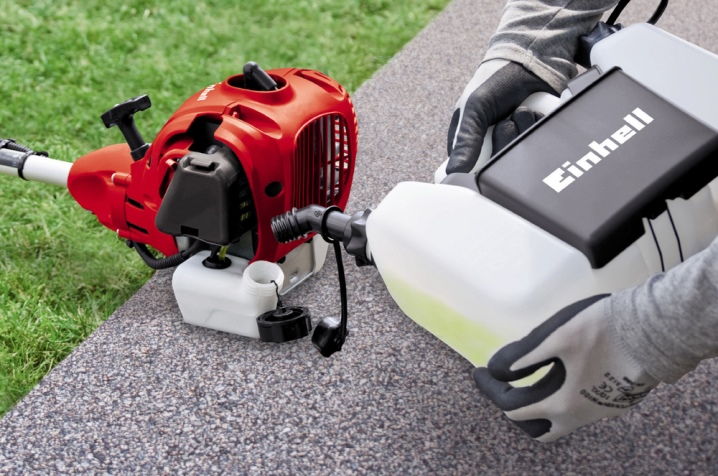The ratio of gasoline and oil for brushcutters

Petrol cutters are a fairly common technique for combating weeds in summer cottages, in household, road and housing and communal services. These devices have two more names - trimmer and brushcutter. These units differ in their engines. The more expensive ones have four-stroke engines, all the others have two-stroke engines. Of course, the latter are the most popular among the population, since they are simpler in design, lighter in weight, and much cheaper than their four-stroke competitors. However, two-stroke models are inconvenient in that the fuel mixture for them must be prepared by hand, maintaining a strict dosage between gasoline and oil. In four-stroke analogs, the mixing of these components occurs automatically, you only need to fill the gas tank and oil tank with the corresponding substances. Let's consider the question of the correct filling of the two-stroke brushcutter, since it depends on how effective and long the operation of such a unit will be.

Standard proportions
Often, problems arise with the proportions of oil and fuel for reliable operation of the brushcutter. The reason for this is completely different information in the sources. You may encounter a difference in the data on the ratio by ten units, and sometimes - by half. Therefore, you involuntarily wonder how much oil is needed for 1 liter of gasoline: 20 ml or all 40. But for this there is a technical passport for the product that you buy in the store. There should be a description of the device, instructions for its operation and instructions on the rules for preparing the fuel mixture.
First of all, it is necessary to take into account the information that the manufacturer recommends, since in the event of a failure of the brushcutter, you can present your claims to him, and not to a third-party source. If there is no instruction in the passport, and even more so if there is no passport, then we recommend looking for another trimmer model from a more reliable seller.
For all other cases, when you have a petrol cutter model in your hands and there is no way to find out its technical features, there are standard proportions of the most probable components of the fuel mixture for a two-stroke engine. Basically, these units use AI-92 gasoline and a special synthetic oil, which contains a solvent for better mixing with fuel. Such oil evaporates slowly and has the ability to completely burn out in the cylinder, leaving no carbon deposits.

The standard ratio of synthetic oil to gasoline is 1: 50. This means that 5 liters of gasoline need 100 ml of oil, and in accordance with this oil consumption per 1 liter of gasoline is 20 ml. Knowing the amount of oil required to dilute 1 liter of fuel, you can easily calculate any rates when preparing fuel for the trimmer. When using mineral oils, the ratio of 1: 40 is most often standard. Therefore, 1 liter of fuel will require 25 ml of such oil, and for a 5-liter canister - 125 ml.
When working with petrol cutters, a person with little experience in operating such equipment will not be difficult to determine and correct the actual amount of oil required for a particular model. You should only pay attention to the exhaust gases (their color, odor toxicity), cycle stability, engine heating and developed power.More details about the consequences of incorrect mixing proportions of gasoline and oil can be expected in another section of the article. There are options for brushcutters running on AI-95 gasoline. This should also be taken into account.
If the manufacturer recommends fuel with such an octane number, then you need to follow the requirements so as not to reduce the operating resource of the equipment.

Mixing rules
And now about how to mix the components correctly. However, it would be more logical to start with an analysis of common, but absolutely unacceptable mistakes that many owners of this mowing unit “sin” with. The following actions are considered as mixing errors.
- Adding oil to the fuel already poured into the brushcutter's gas tank. In this way, a homogeneous fuel mixture cannot be obtained. Perhaps it will work, if only then shake the trimmer for a long time. But it is unlikely that someone will do this, given the severity of the unit.
- First pour oil into a mixing container, and then add gasoline to it. Gasoline has a lower density than oil, so if it is poured into oil, it will remain in the upper layer, that is, natural mixing will not occur. Of course, it will be possible to mix later, but much more energy will be required than if it were done the other way around - pour oil into the poured gasoline.
- Ignoring precise measuring instruments for taking the required quantities of ingredients used. In other words, diluting the amount of oil or gasoline "by eye" is a bad habit when operating motor vehicles.
- Take empty drinking water bottles for preparation of the fuel mixture. Such a container is made of too thin polyethylene, which can dissolve with gasoline.


Considering all of the above, we recommend using the following rules when mixing a fuel mixture for two-stroke trimmer engines.
- Use only clean containers made of metal or special plastic for storing gasoline, oil, ready-made fuel mixture and its preparation.
- Use a watering can for filling gasoline into a dilution container to avoid spilling, and for adding oil - a measuring container with volume risks or a medical syringe for 5 and 10 ml.
- First, pour gasoline into the canister for preparing the fuel mixture, and then oil.
- To dilute the mixture, first pour only half of the planned volume of gasoline into the container.
- Then add to the gasoline the entire amount of oil required to prepare the mixture.
- Mix the contents of the dilution container thoroughly. It is best to stir by making circular movements with a tightly closed container. You should not stir the fuel inside the canister with any foreign object, since it is not known what material this object is made of, what reaction it can enter into with the ingredients of the mixture, how clean it is.
- Add the rest of the gasoline to the mixed mixture and mix thoroughly again.
- You can fill the fuel tank with the prepared mixture.



It must be borne in mind that the finished fuel mixture should not be stored for more than 14 days, as it loses its properties, stratifies and evaporates, which leads to changes in proportions, and therefore, deterioration of trimmer performance.
Consequences of violation of the ratio
The service life of the motor scooter depends on how accurately you follow the manufacturer's recommended proportions of the oil-gasoline mixture. The fact is that the fuel mixture enters the cylinders in the form of gasoline-oil mist. And the task of the oil composition is to lubricate the moving and rubbing parts and surfaces of various parts in the cylinder. If it suddenly turns out that there is not enough oil, and somewhere it will not be enough at all, the parts that touch dry will begin to damage each other. As a result, scuffs, scratches and chips are formed, which will certainly lead to complete or partial engine failure (for example, it can jam).
In the opposite case, when too much oil enters the engine, it does not have time to completely burn out, settling on the cylinder walls and turning over time into solid particles - coke, slag and the like. As you might guess, this also leads to engine failure. The most important thing is that you must not allow even a single violation of the proportion in the direction of a lack of oil. It is better to pour a little oil 10 times than not to add just 1 time. It often happens that this time is quite enough to break the engine.


How to choose for a petrol cutter?
For two-stroke engines, brushcutters use AI-92 or AI-95 gasoline. Most often - the first of the named. There is always information about this in the technical data sheet of the product. If, for some reason, it is not known exactly on what gasoline the trimmer should work, you can pick it up by testing both brands of gasoline in action. Global changes in the engine will not happen from this, and it is quite possible to determine what kind of gasoline this or that model of the unit "loves" more, according to some factors. This will be shown by the developed power, and throttle response, and engine heating, as well as its stable operation at all speeds.
But it is much more difficult to determine the proportions of oil to a certain volume of gasoline. In this case, you need to know at least something about the manufacturer of the equipment. And already according to the standard proportions for this manufacturer, select the proportion for a specific model, taking into account the type of oil.
You can even start selection by country of origin.



For example, for Chinese low-power trimmers, two ratios are mainly used - 1: 25 or 1: 32... The first is for mineral oils and the second is for synthetic oils. We have already talked about the choice of standard proportions for petrol cutters of European and American manufacturers in connection with the type of oil. According to the class of oils for household trimmers, it is necessary to use TB oil according to the API classification. For more powerful ones - the vehicle class.
For information on the ratio of gasoline and oil necessary for a petrol cutter, see the next video.



































































In four-stroke analogs, the mixing of these components occurs automatically, you only need to fill the gas tank and oil tank with the corresponding substances.
The comment was sent successfully.